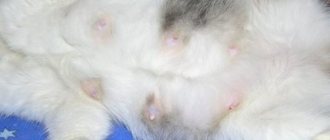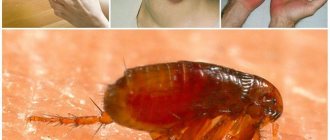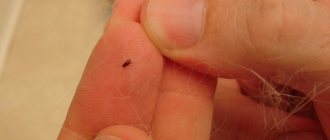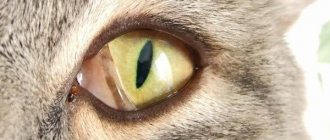Related Posts
- How to remove human fleas at home and with what?
What do flea eggs in dogs and humans look like and how to get rid of them?- Fleas in hamsters: symptoms and treatment
Today, the appearance of fleas on a cat is not such a serious problem, because there is a huge selection of products that allow you to quickly get rid of these parasites. You can learn about how to find out that a cat has fleas, what to do in this situation, and much more from this article.
Appearance of the parasite
To find out if a cat has fleas, you need to know the parasite in person. The most common pest of cats is fleas of the species Ctenocephalides felis.
The insects are small in size - about 3 mm in length. They have an elongated body shape, flattened laterally. The hind limbs are somewhat longer, so the end of the back is raised towards the top. The body is dark brown.
On a note!
Fleas are extremely active, crawl quickly, jump well in height and length, and are difficult to catch. Parasites do not live on a cat’s body; they crawl into it to feed. Therefore, it is possible to determine that a cat has fleas based on indirect evidence.
The larvae differ in appearance from adults, lead a different lifestyle, feed on food waste, rot, and dead particles of the epidermis. You can find them under the rug, in the pet’s sleeping place, near its toilet. They look like small off-white worms.
Flea eggs do not exceed 0.5 mm. Females literally shoot them away from themselves. They can only be detected if a room or individual area is heavily infested. They look like grains of sand. Rarely found in animal fur.
Symptoms of fleas in a cat
global $ads_google; //data-ad-slot=”2475549904″ $ads_google = empty($ads_google) ? false : true; ?> if ($ads_google == false) {?>
$ads_google = true; ?> } ?>
Every owner can easily determine if a pet is infested with cat fleas by the following signs:
- The cat is behaving atypically because fleas are bothering her with their bites. The animal constantly scratches its fur and nervously licks it. Some pets begin to roll on their backs on the floor or sand.
- Some time after infection, the cat begins to feel even worse: she sleeps poorly, often waking up - she is bothered by itching. Due to constant scratching, the appearance deteriorates.
- The final diagnosis can be made by carefully examining the animal. The flea, reaching sizes up to 4 mm, is clearly visible to the naked eye. Fleas in cats lead to scratches on the body, which turn red and fester when exposed to microbes. Dark lumps are noticeable in the fur: such feces are left by a flea. Pets sometimes have an allergic reaction to insect waste products and saliva.
To finally understand whether a cat has fleas, you should put it on a sheet of white paper and carefully comb it with a fine-toothed comb. If dark grains fall from the wool, you should start fighting. Parasites are carriers of infectious diseases. Although they do not live on humans, they often bite him.
Symptoms of infection by behavior
You can identify fleas in a cat by its behavior. Insects cause a lot of inconvenience, pain, and affect the well-being of the pet. Fleas in a kitten lead to delayed growth and development. In case of severe infection, it leads to death.
Insects bite painfully, the cat reacts to bites with plaintive meows, sudden jumps, or digs its teeth into the fur and tries to get something. The stronger the infection, the more restless the cat.
- Sleep is disturbed, the pet constantly shudders, moves its whiskers, ears, and groans.
- During the day she cannot sit in one place for a long time, periodically jumps up, jumps, tries to climb somewhere, in the hope that the parasites will not get her there.
- It itches constantly, digs its teeth into the fur, tears the skin with its claws, and pulls out the fur with its teeth.
- Appetite spoils.
It is impossible not to replace such changes. But even if there is not enough such evidence, you should pay attention to the appearance of the pet.
The most common signs of flea infestation in cats
A colony of parasites does not immediately make itself known, and how can you tell if your cat has fleas?
Owners should pay attention to changes in her behavior, in which:
- the pet begins to zealously bite into the fur;
- There is an inexplicable nervousness in the cat. The animal is bothered by severe itching, which she informs her owner about by continuous meowing;
- upon palpation and inspection, you can feel and see small brownish tubercles, which are products of insect excretion;
- While combing, the fleas themselves come into view - the culprits of the disturbance.
Veterinary practice distinguishes two stages of flea infestation, the first of which proceeds quite calmly and does not greatly annoy the cat. The pet, as before, is playful and eats well, but a visual inspection does not yield results - several fleas are almost impossible to see due to their fast movement and small size. Therefore, it is very difficult at the initial stage of infection to identify signs of flea activity in a cat, with the exception of the only symptom - frequent scratching.
At the same time, it is simply impossible to skip the second stage: due to the rapid growth of the flea colony, the symptoms become more pronounced:
- the pet turns into a gloomy and downtrodden creature;
- there is severe weakness and exhaustion;
- cheerfulness and playfulness disappear;
- the fur begins to roll into shreds and fall out;
- attacks of vomiting are possible;
- the skin loses its immunity, which leads to the development of dermatitis.
When examining a cat if fleas are suspected, special attention should be paid to the favorite areas of the body of these parasites - the stomach, neck and area near the jaw.
Usually, attentive owners do not bring the disease to the final stage and try to show the cat to a qualified specialist as quickly as possible, who will accurately determine the severity of the infection and prescribe the correct effective treatment. Independent control may not bring the desired result and lead to the development of dangerous diseases transmitted by fleas.
Symptoms of infection by appearance
Signs of the presence of fleas
Lack of appetite, poor sleep, scratching, and constant nervous tension cannot but affect the appearance of the cat. The fur stops shining, and places where it is missing appear. The cat looks sloppy and dirty because parasite excrement remains on the hairs.
Important!
When an animal is severely infected, it rapidly loses weight and begins to get sick. If you don't take emergency measures, everything could end in the death of your pet.
Signs that a cat has fleas
If you suspect that your cat has parasites, you must first understand that these are actually fleas and not ticks. Even inexperienced cat owners can detect the characteristic symptoms. You need to carefully monitor your furry pets.
If the cat seems worried, often itches, and sometimes bites into parts of the body, this is direct evidence of infection. Quite often, characteristic wounds appear at the sites of animal bites.
It is not difficult to identify signs of fleas using a simple method. You need to take a white sheet of paper and try to carefully comb the hair out of the animal. If there are traces of flea activity, small black or brown grains will be visible on the white sheet. You can confirm your suspicions by trying to drop water on the dots. Under the influence of liquid, flea feces become brown in color.
Examination of the animal
You can easily find fleas on a cat if there is a severe infestation. Just move the fur aside and take a closer look. Small insects that move quickly will be found in the undercoat layer. Even if they are not there, fleas can be recognized by indirect evidence.
- On the body there are wounds from bites, scratches, scratches from teeth, claws. Cat fleas bite painfully, so the animal immediately digs its teeth into the affected area or tries to scratch it with its paw. Such actions further damage the skin.
- The bites leave a strong itch, which causes the cat to scratch constantly. A secondary infection penetrates into the wounds, pustules, ulcers, irritation, and inflamed areas form on the body.
- You can detect fleas on a cat by looking at the excrement of the parasites. They remain on the fur in the form of small grains of dark sand. Well visible on light coats.
Appearance of fleas
There are several types of fleas. Felids belong to Ctenocephalides felis . They have no wings, their body is flattened on the sides, covered with shiny brown scales. They are agile, with developed limbs that help them jump up to 30 cm in length and up to 19 cm in height.
Adults reach 3 mm in size, females – 2 mm. The well-fed ones become twice as big. Their mouth is like a sharp stiletto, which they use to pierce the skin and drink blood. Once eggs are laid, they hatch within 2 weeks. The female creates colonies of offspring, even jumping, “shooting” larvae out of herself. Lays up to 400 eggs per day.
The larvae look like fleshy white caterpillars. They can rarely be seen on an animal; more often females scatter them around the house. Flea eggs have a smooth shell. Therefore, they roll off the wool and rarely linger. It is easy to understand that there are fleas in the house by examining the places where the cat often rests. There will be a lot of larvae there.
Where do fleas come from?
A flea is a small wingless insect. It has incredible jumping ability and mobility. The flat, compressed body protects the parasite from external damage. So, it is almost impossible to crush it with your finger, only by first squeezing the insect between the nail plates. Nature has endowed these insects with sharp jaws, with which they dig into the skin of the victim and drink blood. Cats are usually very sensitive to flea bites. You can understand the animals, because the bugs bite in quite painfully.
© shutterstock
Owners of domestic cats are extremely surprised when they discover harmful insects in their cats. Where do fleas come from, because the cat does not go outside and does not communicate with its own kind. But insects can be brought not only by cats, but also by people - on shoes, clothes, children's transport, etc.
Cats that go outside for walks are at particular risk of becoming infected with fleas, which is generally understandable. Furry participants in exhibitions and various competitions also often pick up parasites at event venues.
Symptoms of flea infestation
Pet behavior
When a problem appears, the pet’s behavior does not change for the first few days. He is just as active, eats and sleeps. Then how can you tell if a cat has fleas? Place it in a bowl of water. Fleas do not like her and will quickly begin to leave the owner’s body.
As the number of insects increases, the animal becomes restless and painful sensations appear. If they attack a kitten, this slows down development and stunts growth. You can tell that fleas have appeared by your pet’s behavior:
- suddenly begins to chew the fur;
- meows pitifully, shakes his head;
- cannot relax;
- sleeps poorly, rarely;
- often shudders, twitches his ears, moans;
- constantly changes location, trying to find a place where insects will not reach him;
- tears fur and skin with claws;
- appetite decreases or disappears.
Because the cat is unable to get rid of the fleas that constantly bite him on his own, he becomes irritable and aggressive. Can respond to affection with a hiss or a paw strike.
Visible signs
When a cat is infected, it is easy to understand by its appearance. Poor sleep, lack of appetite, nervous tension and severe stress negatively affect the coat. It loses its shine, begins to fall out, and areas of baldness appear. Redness, swelling occurs, and the wounds sometimes bleed.
The coat looks dirty, sloppy, and gets dirty with parasite excrement. If the infestation is severe, it will not be difficult to find out that fleas have attacked - the pet rapidly loses weight and begins to get sick. Dermatitis develops, accompanied by inflammation of the skin, dry scales of the dermis and areas of alopecia appear.
Toxoplasmosis
Roundworms in cats
Is it possible to give deworming medication to a pregnant cat?
Each flea drinks about a drop of blood every day. With a large accumulation of them, blood loss increases, and the cat develops anemia. This can be understood by certain signs - the pet weakens, becomes inactive, and the mucous membranes turn pale. Shortness of breath appears, appetite decreases or disappears.
How does a domestic cat get fleas if he doesn't go outside?
If the cat is an indoor cat and doesn’t walk outside at all, where did he get fleas from? Flea eggs and larvae can get into an apartment from the street from a person - we can, without knowing it, bring them on shoes or clothes. If there are mice or rats in the house, they can carry fleas and cause an infestation for your cat. Also, the presence of other pets in the house, such as dogs, can affect the spread of fleas to other human friends. Fleas can move into your house from neighbors or from the entrance when you simply open the door to the landing. If a domestic cat likes to walk on the balcony, fleas can overtake it there too, coming from neighbors or from a pigeon perched on the balcony, and then the owners can guess where the cat got fleas from. So a cat doesn’t have to walk outside to pick up parasites - fleas and other insects. Find out the answer to the question, can cat fleas bite humans? The answer is in the article at the link.











